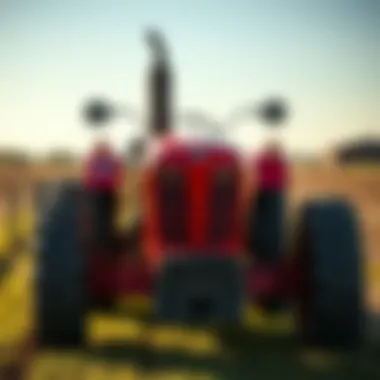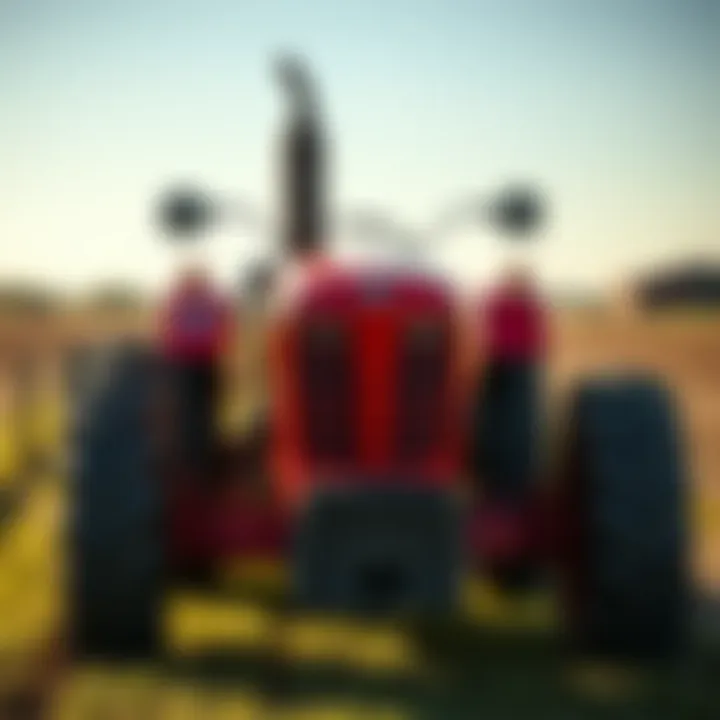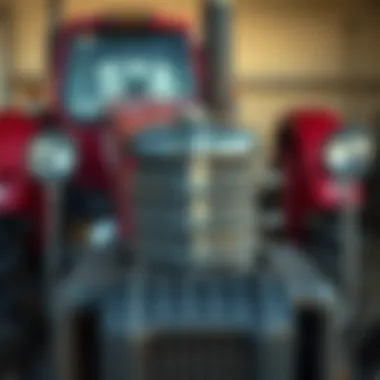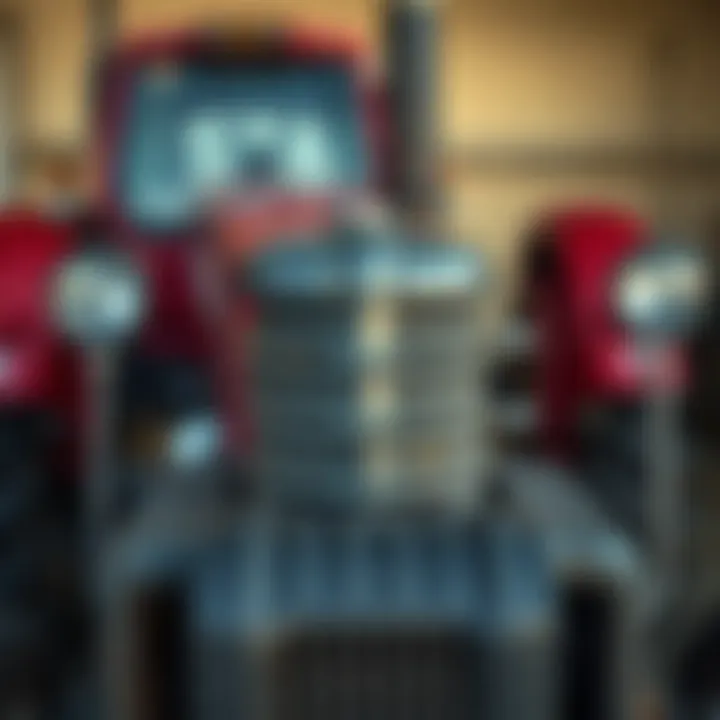Understanding Ferguson Tractor Parts: A Complete Guide


Foreword
In the realm of modern agriculture, Ferguson tractors hold a significant place, especially among farming enthusiasts and practitioners who appreciate the blend of innovation and tradition. These machines, known for their robustness, depend on quality parts to function seamlessly. Understanding the components that make up Ferguson tractors is not just beneficial—it's essential for ensuring longevity and reliability. This guide underscores key concepts, recent trends, and practical applications related to Ferguson tractor parts, offering insights that are indispensable for anyone serious about maintaining their machinery in peak condition.
Key Concepts and Terminology
Basic Definitions
When discussing Ferguson tractor parts, it's pivotal to grasp fundamental terms that often bubble to the surface. Here are a few essential definitions:
- Chassis: The framework that supports the tractor's components.
- Hydraulics: Systems that use fluid power to facilitate movement, crucial for many tractor functions.
- OEM Parts: Original Equipment Manufacturer parts designed specifically for the tractor, ensuring compatibility and performance.
- Aftermarket Parts: Components manufactured by firms other than the original maker; they may offer cost savings but can vary in quality.
Historical Context
Ferguson tractors, pioneered by Harry Ferguson in the 1930s, were revolutionary in their implementation of three-point hitch systems, which revolutionized farming practices. The significance of their components lies not just in their engineering but in their historical evolution, which mirrored advancements in agricultural techniques.
From the initial models to today's modern design, this trajectory highlights a journey that reflects both technological progress and a persistent commitment to enhancing farming efficiency. The rich history of these machines informs both their operation and the value of original parts.
"Choosing genuine Ferguson tractor parts not only preserves the functionality of the machine but also honors its legacy of innovation."
Recent Innovations and Trends
Technological Advancements
As agriculture progresses, so too do the technologies that support it. Innovations in Ferguson tractor parts have led to improvements in efficiency and sustainability. Advances such as precision farming technology, GPS integration, and advanced hydraulics systems enhance the operational capability of these tractors. Farmers today can operate with greater accuracy, leading to reduced waste and improved yields.
Sustainable Practices
In the current environmental landscape, farmers are increasingly turning to sustainable practices. Utilizing parts that promote energy efficiency and reduce emissions is becoming a norm. Ferguson, alongside emerging trends in the tractor industry, emphasizes eco-friendly components, reflecting a shift towards sustainability. Not only does this align with global efforts to combat climate change, but it also underscores the importance of conservatively using resources on the farm.
Practical Applications and Techniques
Step-by-step Guides
Maintaining Ferguson tractor parts doesn't have to feel like rocket science. Here’s a simple guide to get you started:
- Inspect the Engine: Regular checks for oil levels and leaks can prevent costly damages.
- Check Hydraulic Fluids: Ensure that hydraulic systems are adequately filled and free of contamination.
- Replace Filters: Air and fuel filters should be replaced at regular intervals to maintain efficiency.
Case Studies
Consider the example of a farmer in Nebraska who transitioned to using OEM parts exclusively. Reports indicated an increase in fuel efficiency by an impressive 15% after switching. Another case in Oregon highlighted farmers combining modern parts with trusted historical components, resulting in a smoother operation and higher productivity on diversified crop fields. These experiences emphasize that knowing the parts inside your tractor can impact not just performance but the overall farming enterprise as well.
Identifying and understanding Ferguson tractor parts can lead to better decision-making, streamlining operations, and ultimately enhancing productivity on the farm. With the historical context, recent innovations, and practical guides at one's disposal, anyone involved with Ferguson machinery is better prepared to navigate the challenges that come with tractor maintenance.
Prelude to Ferguson Tractors
Understanding Ferguson tractors is crucial for anyone involved in agriculture, whether a seasoned farmer or a curious enthusiast. These machines have carved a niche in farming history due to their innovative designs and reliable performance. Knowing their origins and how they evolved over time can provide valuable insight into their current relevance and usage.
History and Evolution
Ferguson tractors trace their roots back to the mid-20th century, primarily attributed to the pioneering work of Harry Ferguson. In 1946, the introduction of the Ferguson TE20 marked a significant step forward in agricultural mechanization. This model was a game-changer that brought the concept of the three-point hitch into reality, which allowed for better control of implements and more efficient farming techniques.
As these tractors evolved, new models emerged, featuring improvements in engine design, power, and user-friendliness. By the 1960s, Ferguson had garnered a reputation for combining ruggedness with ease of operation. Their tractors could be found in fields from the U.S. to Europe, aiding a variety of farming tasks from plowing to hauling. The brand became synonymous with progress in agriculture during this time.
The transition into modern machinery further led to the enhancement of Ferguson parts, aiming to increase efficiency and bolster productivity. Parts that are still in demand today are derived from this rich history, reflecting decades of engineering advancements that focus on function and durability.
Significance in Agriculture
Ferguson tractors have held a pivotal role in shaping modern agricultural practice. These machines are not just tools; they are the backbone upon which many farms operate. By maximizing soil cultivation, improving crop yields, and minimizing labor hours, they have empowered farmers to achieve more with less.
In addition, the inherent versatility of Ferguson tractors makes them suited for a range of tasks, effectively addressing various agricultural needs such as:
- Cultivation - Preparing the soil for planting is made easier with reliable machinery.
- Harversting - Efficient power allows for fast and effective harvests, minimizing crop loss.
- Transporting - Capable of moving heavy loads, they support the big haul of goods to market.
Moreover, they help in conservation efforts by promoting practices that maintain soil health and sustainability. As farming becomes increasingly reliant on technology and innovation, Ferguson tractors stand as a testament to practical design marrying with agricultural needs.
"The legacy of Ferguson tractors isn't just about machinery; it's about fostering advancements that drive the agricultural industry forward."


Understanding the significance of these tractors is vital for anyone invested in the agricultural sector. Knowing how they evolved will also bring clarity into the types of parts available today and the essential role they play in cultivation and production.
Types of Ferguson Tractor Parts
Understanding the different types of Ferguson tractor parts is crucial for any farmer or enthusiast looking to maintain or restore these machines. Ferguson tractors, known for their innovation and reliability, contain several distinct parts that contribute to their overall functionality. Familiarizing yourself with these components can enhance efficiency in agricultural operations and ensure longevity of the machine. Each part plays a specific role, and recognizing their importance can guide users in making informed choices regarding repairs and replacements.
Engine Components
The heart of any tractor is its engine. In Ferguson tractors, the engine components include the cylinder block, pistons, crankshaft, valves, and fuel injection system. Each of these parts works concertedly to convert fuel into mechanical energy, which in turn powers the tractor. A well-maintained engine ensures optimal performance, making it essential to regularly check for any signs of wear.
Common maintenance tips:
- Regular oil changes
- Replacing air filters to ensure airflow
- Checking the coolant levels to prevent overheating
When issues arise, sourcing genuine engine parts, like the Massey Ferguson 35 clutch plate, plays a significant role in restoring performance. Authentic parts have been engineered to meet the specifications of the original design, promoting efficiency and reliability.
Transmission Parts
Transmission parts govern the tractor's ability to transmit power from the engine to the wheels. Key components include gears, shafts, and linkage systems. These parts control the tractor's speed and torque, directly influencing how it handles different terrains.
Importance of keeping transmission parts in check cannot be overstated. Regularly inspecting for signs of leaks, strange noises, or difficulty in shifting gears can save time and money on repairs. Moreover, using original transmission parts like the Massey Ferguson 135 gear shift ensures compatibility and maintains the smooth operation of the tractor.
Hydraulic Systems
Hydraulic systems are indispensable for tasks requiring immense force, such as lifting heavy loads or powering implements. The components include hydraulic pumps, valves, and actuators. A well-functioning hydraulic system improves the productivity of the tractor.
Always ensure the hydraulic fluid is at the correct level. Fluid contamination can lead to system failure, which is both costly and time-consuming. Using OEM hydraulic parts, like the Massey Ferguson hydraulic cylinder, guarantees optimal performance in lifting and operating attachments efficiently.
Chassis and Frame
The chassis and frame provide the basic structure and support for the entire tractor. This includes the metal frame, wheel assemblies, and suspension components. A robust chassis allows the tractor to endure heavy loads and rough terrain.
Neglecting the integrity of the frame can lead to serious issues during operation. Routine checks for cracks or corrosion are essential. If any imperfections are found, sourcing durable parts such as the Massey Ferguson 265 rear axle is critical for maintaining a safe and dependable tractor.
Electrical Components
Electrical components are becoming increasingly important with the advent of more advanced tractors. These include the battery, starter motor, wiring harnesses, and ignition system. They help start the engine and power various systems such as lights and gauges.
A malfunctioning electrical system can leave a farmer in a bind. Regularly testing batteries and ensuring connections are secure can prevent unexpected breakdowns. Opting for genuine electrical parts like the Massey Ferguson ignition switch not only ensures compatibility but also enhances the reliability of the tractor's electrical systems.
In summary, understanding the types of Ferguson tractor parts is essential for anyone involved in agriculture. Each component plays a critical role in ensuring the tractor operates smoothly and efficiently. By focusing on genuine parts and regular maintenance, farmers can keep their Ferguson tractors running in top-notch condition for many years.
Finding Authentic Ferguson Parts
Sourcing genuine parts for Ferguson tractors is not just a matter of convenience; it’s crucial for maintaining performance and safety. Authentic Ferguson parts guarantee a level of quality and compatibility that can make all the difference, especially for farmers who rely on their equipment day in and day out. When looking for parts, one must carefully consider where to obtain them, as counterfeit and substandard components could lead to system failures or inefficiencies. By choosing authentic parts, owners benefit from enhanced reliability, faster service, and often, better long-term value.
Authorized Dealers
Authorized dealers are the backbone of sourcing authentic Ferguson parts. These professionals not only stock genuine parts but also serve as hubs of knowledge regarding product specifications, compatibility, and alternative options. When you go through them, you can be confident you are purchasing from an entity that has been vetted by the manufacturer.
Moreover, buying from an authorized dealer often provides advantages such as warranties and customer support that can make a significant difference in your overall satisfaction. Many dealers also offer services like installation or maintenance advice, which can be invaluable if you're not a DIY expert. In a world where reliability is paramount, choosing an authorized dealer is like having a safety net beneath your feet.
Online Marketplaces
The digital age has transformed the way parts are bought and sold, with online marketplaces becoming an increasingly viable option for sourcing Ferguson parts. Websites such as eBay and Amazon offer a wide variety of parts, which can be convenient. However, caution is advised here. The nature of online platforms means you have to do your homework. Not everyone on these sites is selling genuine parts. It's crucial to check reviews, seller ratings, and any warranties mentioned in listings. Additionally, many online retailers now provide comprehensive guides that can help you determine compatibility with your specific Ferguson model. But, remember, not all heroes wear capes; some might just be savvy online shoppers equipped with the right information.
Second-hand Parts
Second-hand parts can be a double-edged sword. On one hand, they can save you a heap of cash, especially for older tractor models where new parts may be out of circulation. On the other hand, they come with their own set of risks. It’s important to inspect any second-hand component thoroughly. You should ask for its history: Why was it replaced? How many hours of use does it have?
Buying from reputable salvage yards or trusted community forums can mitigate these risks. Forums like Reddit often have dedicated sections for farmers who share experiences and could point you toward reliable sources of second-hand parts. However, you should never compromise on quality. Just because it’s cheaper doesn’t mean it’s worth it when it could lead to more significant issues down the road.
Remember: Sourcing parts from various venues emphasizes the importance of quality over price. Opting for genuine parts, even when considering second-hand options, is a wise strategy for long-term operation and maintenance success.
Compatibility Considerations
Compatibility is a linchpin in the realm of Ferguson tractor parts. When one embarks on the journey of sourcing replacements or enhancements for their tractor, understanding compatibility ensures that the components will integrate seamlessly, maximizing the efficiency and longevity of the machine.
Model-Specific Parts


Ferguson tractors come with a variety of models, each bearing its distinct specifications. Model-specific parts are tailor-made for these unique characteristics, ensuring that they fit perfectly and function optimally. For instance, a part designed for a Ferguson FE-35 may not necessarily be compatible with an MF 135; despite both models sharing a legacy, their engineering nuances require different components.
Farmers and enthusiasts must be diligent in identifying the exact model of their tractor when seeking parts. Often, the engine size, year of manufacture, and even location of manufacture can impact the compatibility of parts. Checking the tractor’s manual or consulting with authorized dealers can provide crucial information in this respect.
- Important Points about Model-Specific Parts:
- Precision engineering for specific models
- Enhanced performance and reduced risk of malfunction
- Easier installation as parts align perfectly with existing configurations
Cross-Compatibility
Cross-compatibility refers to the potential for parts from one model to be used in another model. While this can provide cost efficiencies and broaden the options available to the user, it is a double-edged sword. A part from a different tractor model may fit into the assembly, but if it is not engineered to work with the specific system, it could ultimately lead to performance issues or even damage.
Even though some parts like filters and oils are often interchangeable, critical components such as hydraulic systems or transmission parts require serious scrutiny. For example, using hydraulic pumps designed for the Ferguson TO-20 on a TO-30 might seem feasible, but discrepancies in power output could compromise the entire hydraulic system.
To mitigate risks associated with cross-compatibility, it’s advisable to:
- Consult the tractor's manual for guidance.
- Select parts that are approved for cross-use by professionals.
- Seek out community forums or local farming clubs for shared experiences and insights.
_
Maintenance of Ferguson Tractor Parts
Maintaining Ferguson tractor parts goes beyond the mere act of keeping machinery running; it embodies a commitment to efficiency, safety, and longevity in agriculture. Regular maintenance is akin to preventive healthcare for tractors. Addressing minor issues before they snowball into major repairs not only saves time but also safeguards your investment. Moreover, the quality of the parts used significantly affects the overall performance of the tractor. Here’s a closer look at the components of this essential maintenance routine.
Regular Inspection
Regular inspection is the bedrock of effective maintenance. Just as farmers routinely check their fields for weeds and nutrient deficiencies, inspecting tractor parts ensures that everything is in order. This practice can help catch potential problems early on. Start by checking:
- Fluid Levels: Oil, coolant, and hydraulic fluid should be at the correct levels to prevent overheating and other issues.
- Belts and Hoses: Look for signs of wear or cracking. These components are often under-directed stress and can fail without warning.
- Tires: Ensure that they are properly inflated and check for any uneven wear or damage that might affect performance.
- Battery Condition: Corrosion on terminals or a weak battery can lead to starting issues, especially in colder months.
There’s a simple saying: "An ounce of prevention is worth a pound of cure." Engaging in routine inspections can prevent costly breakdowns and maintenance in the future.
Lubrication Practices
Lubrication is another key aspect of tractor maintenance that cannot be overlooked. Think of it as the grease that keeps the wheels of your machinery turning smoothly. Proper lubrication reduces friction and wears on moving parts, thus prolonging the life of your equipment.
When it comes to lubrication, consider these points:
- Use the Right Lubricants: Different components require specific types of oils and greases. Consult your manual for the right specifications.
- Frequency Matters: Don’t wait until you hear a grinding noise to add lubricant. Regularly scheduled lubrication of joints and moving parts will keep everything in check.
- Clean Surfaces: Before applying lubricant, ensure that surfaces are clean. Dirt can act as an abrasive agent, shortening the lifespan of the machinery.
An effective lubrication routine can significantly enhance the reliability and performance of Ferguson tractor parts. It's a small effort that pays off handsomely.
Replacement Schedules
Like clockwork, every component of your tractor has a lifespan. Understanding when to replace vital parts is critical to maintaining efficiency and safety. For parts like filters, belts, and hydraulic components, adhering to recommended replacement schedules is crucial.
Here are some guidelines to keep in mind:
- Follow Manufacturer Guidelines: The owner’s manual often provides a replacement schedule based on hours of operation. Adhering to these recommendations is essential.
- Monitor Performance: Changes in performance or unusual sounds should raise immediate red flags. Sometimes, it’s better to replace a part early than to risk a failure.
- Track Maintenance Records: Keeping a detailed log of what has been replaced and when can help you predict future maintenance needs. It can also be an invaluable resource when seeking to sell the tractor.
The wise farmer knows that the key to a successful harvest isn't just in planting seeds; it's also in caring for the equipment that helps tend to the crops. Regular maintenance of Ferguson tractor parts enables smooth operation and guarantees that you can count on your machinery when it matters.
"Taking care of your tractor means taking care of your livelihood."
For further information on tractor maintenance and parts, feel free to check out Wikipedia and Britannica.
To connect with other farmers and enthusiasts, visit communities on platforms like Reddit or explore related groups on Facebook.
By prioritizing maintenance, you can ensure that your Ferguson tractor parts remain reliable for years to come.
Benefits of Using Genuine Parts
In the world of Ferguson tractors, the phrase "genuine parts" is more than just marketing jargon; it signifies reliability, performance, and a prolonged lifespan for your machinery. Understanding the benefits of using these authentic components can make a world of difference, especially for farmers and enthusiasts who depend on their tractors for daily tasks. Nothing can substitute the integrity that comes from original parts—this article delves into the vital advantages you gain by choosing genuine over aftermarket components.
Reliability
When it comes to machinery, reliability is non-negotiable. Genuine Ferguson parts are crafted to meet strict standards enforced by the manufacturer. These standards ensure that each component performs as expected without unnecessary wear and tear, which can often lead to breakdowns. Consider a situation: A farmer is working in the middle of harvest season. The last thing they need is an unexpected tractor malfunction. By using genuine parts, one can rest assured that the equipment will operate smoothly, decreasing the risk of breakdowns during critical work times.


Genuine components have been tested rigorously and designed for seamless compatibility. Here are some key points about reliability:
- Quality Assurance: Each part is constructed under strict industry regulations, resulting in dependable performance.
- Proven Track Record: Equipped with historical data and positive feedback from past users, genuine parts have proven themselves time and again.
- Warranty Security: Most authentic parts come with a manufacturer’s warranty, providing additional peace of mind.
Performance Enhancement
When tractors work harder, it’s not just about power; it’s about finesse and efficiency. Genuine parts are engineered for optimized performance, ensuring that everything works in harmony. For instance, consider a hydraulic system. Using authentic hydraulic components ensures that pressure and flow rates meet the tractor’s specifications, which is crucial for tasks like lifting or plowing.
Here are performance benefits to keep in mind:
- Enhanced Efficiency: With genuine parts, performance is consistent, often improving fuel efficiency and operational speed.
- Matchless Compatibility: Each genuine part is designed to fit perfectly, minimizing operational hiccups.
- Better Engineering: The innovative technology used in authentic parts often surpasses that found in imitations, resulting in smoother operations overall.
Long-term Cost Savings
Choosing genuine parts isn’t merely about spending more upfront; it’s an investment that can lead to significant cost savings in the future. The durability of genuine parts often means they last longer, requiring fewer replacements over time. A stitch in time saves nine—investing in quality now prevents more extensive repairs later.
Let’s break down the economics:
- Lower Maintenance Costs: With reliable parts, there are fewer unexpected repairs or replacements, saving time and money.
- Increased Resale Value: A tractor in good working order, maintained with authentic parts, retains higher resale value.
- Operational Efficiency: Enhanced performance means potentially less fuel usage and better productivity, reducing operational costs over time.
An investment in genuine Ferguson parts is not merely the cost of replacing a component; it's a strategy for maintaining a long-term resource that supports the backbone of modern agriculture.
In summary, the benefits of using genuine parts vary from immediate tangible returns to long-term operational sustainability. Understanding these elements can solidify your choice and guide you toward smarter decisions, all while keeping your Ferguson tractor running at its best.
Case Studies: Successful Ferguson Tractor Restoration
Restoration projects of Ferguson tractors pack quite a punch when it comes to illustrating the enduring legacy and functionality of these machines. Delving into real-world examples not just enlightens enthusiasts about the practicality of Ferguson tractor parts, but also showcases the craftsmanship and dedication that goes into making these classic tractors roar back to life. Engaging with these case studies provides a treasure trove of insights for aspiring restorers and farmers alike.
Restoration Projects
There are a number of noteworthy restoration projects that highlight how Ferguson tractors have continued to thrive in modern farming environments. One classic example is the restoration of a 1955 Ferguson TE20. This project, taken on by a group of local farmers, involved painstaking attention to detail. They sourced original Ferguson parts from various authorized dealerships. The end result was a beautifully restored tractor that not only serves the purpose of traditional farming but also turns heads at local tractor shows.
- Key Steps in the Restoration:
- Assessing initial condition and determining parts requirements.
- Locating hard-to-find components, such as the original carburetor.
- Implementing modern techniques to refurbish paint and chassis.
Another compelling case is that of a 1968 Ferguson 135, brought back to life by a retired mechanic. His story illustrates the importance of patience and knowledge in the restoration process. He documented every step, which has become a guide for others. His insistence on maintaining factory specifications paid off. The tractor became a reliable workhorse on his small farm, illustrating how historical machines can still perform efficiently with the right parts.
- Notable Techniques Used:
- Custom fabrication of small parts when originals were not available.
- Incorporation of modern safety features while retaining the old charm.
User Testimonials
User testimonials serve as a bridge between theory and actual experience in the field. Hearing from those who have undertaken restoration projects can provide aspiring restorers with motivation and direction. One user, Jane from Iowa, shared how her father's old Ferguson tractor sparked not just nostalgia but a vision for sustainable farming practices.
"Restoring my father’s Ferguson 20 taught me more than just mechanics; it ignited a passion for keeping old technology alive alongside modern practices. It's a blend of history and innovation!"
"These tractors represent not only machinery but also a connection to farming heritage that many young farmers are eager to revive."
Another anecdote comes from Mike, a dealer who often assists people in finding parts. He notes, "When someone comes in asking for a Ferguson part, you can see the spark in their eyes—it’s not just a machine; it’s a part of their family history. That’s something special."
User testimonials not only celebrate the tangible benefits of restoring Ferguson tractors but also underscore the emotional connection people hold towards these machines. The stories weave together a narrative of passion, pride, and community, where each restored tractor tells its own tale.
Together, these case studies and user experiences highlight the importance of Ferguson tractor restoration - serving as a reminder that these machines are not merely tools but vessels of history and the promise of sustainable farming.
The End and Future Trends
As we wrap up this exhaustive guide on Ferguson tractor parts, it’s essential to reflect on the profound implications of these components in today's agricultural landscape. The marriage of tradition and innovation drives the relevance of Ferguson tractors, symbolizing not just a means to an end but a testament to enduring engineering excellence. The importance of staying abreast of future trends cannot be overstated; it transcends mere efficiency in farming—it’s about sustainability, adaptability, and embracing the inexorable march of technology.
Innovations in Tractor Parts
The world of agricultural machinery is in constant flux. New developments in technology have led to groundbreaking innovations in tractor parts that promise to transform farming practices. For instance, sensors now integrate with engine components to monitor performance and predict maintenance needs before they become urgent. This predictive technology not only extends the life of your tractor parts but also enhances reliability.
Another exciting advancement is the shift toward modular designs, allowing farmers to swap out components with ease. This could mean anything from upgrading the transmission system to incorporating advanced hydraulic systems that improve efficiency in the field. As these innovations emerge, we see a clearer pathway toward precision agriculture, where every inch of land is maximized for productivity.
"Every piece of equipment reflects years of development, but tomorrow's innovations will define the future of farming."
Sustainability Considerations
Another pressing trend on the horizon is sustainability. As the agricultural sector faces mounting pressure to reduce its carbon footprint, the push for greener tractor parts is gaining momentum. Many manufacturers are now focusing on creating parts from recycled materials or designing components that can be easily disassembled for repair rather than replacement. This shift not only lessens the environmental impact but can also lead to significant savings on costs over time.
Moreover, new advancements in alternative fuel sources, such as biofuels or electric power, are reaching the tractor market. These innovations challenge the norms of traditional farming and cultivate a new standard for sustainable practices. In this context, the importance of sourcing genuine parts tailored for these modern approaches becomes vital. Farmers must ensure that their tractors are not just tools but embodiments of responsible stewardship of both land and resources.
As we gaze into the horizon of agricultural innovation and sustainability, it’s clear that the future of Ferguson tractor parts is not just about keeping machinery running; it’s about forging a path toward a more efficient, environmentally-friendly, and technologically advanced approach to farming.















